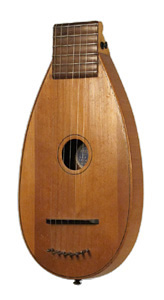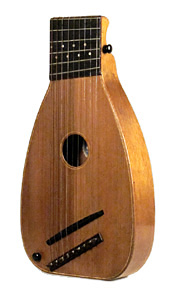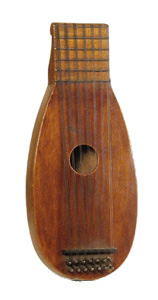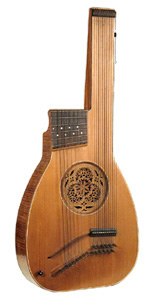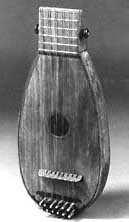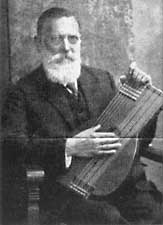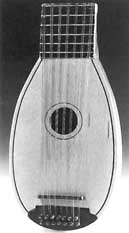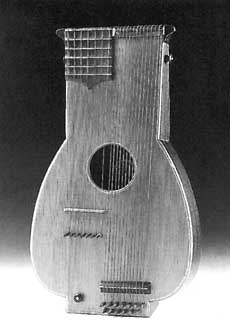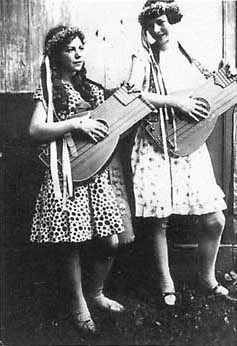Articles (copied and
bookmarked on this page for permanence)
1. Stössel-Lauten - Andreas
Michel, 1995 (or get it straight from the horse's mouth in German HERE)
2. Stössel-Laute
- DieMusikinstrumentensammlung, 1993
3. The Stössel lute: A Folk Instrument for Everyman -
Revisited after 40 years of Oblivion - Stefan Lieser,
1985
Thanks to Chris Wilhelm for translating all the German literature
he and I have dug up on Stössel!
Stössel-Lauten
From Zithern: Musikinstrument zwischen Volkskutur und
Burgerlichkeit - Andreas Michel, 1995 (used by permission)
Translated from the original German by Chris J. Wilhelm of Ketchikan, Alaska,
September 2001.
In response to the mass production of cheap autoharps, the Cologne violin
builder Georg Stössel (1867-1943) invented an instrument in 1914, which united
characteristics of both zithers and lute-like instruments. It had a flat,
zither-like body with a lute-like shape, sides and arched top, which is put
together with Spänen (?)); a short, wide neck; a fretboard with three or at the
most five frets; the strings are fretted by reaching the hand over the headstock
and top saddle, parallel to the path of the strings themselves.
The design represents a compromise between simple chordophones, like zithers,
and necked chordophones. The neck was minimized, so were the numbers of frets.
In order to make possible the grip over the headstock, the strings and their
fastenings were set into the neck and the tuners were located on the body.
Although one may look upon the seven string Stössel lute as a basic style, the
inventor experimented with a number of shapes and models.
It is clear from the patent description that the inventor had many plans for
his "stringed instrument, characterized by the organization of a fretboard
perpendicular to the strings". In only three decades he built a few hundred
different representations of his lute instrument. Besides the many variations
regarding the numbers of strings, there were attempts with single and double
courses of strings.
The name by which this instrument is called today derives from the inventor.
In the first learning materials for the instrument, for example, a manual from
1920 by H. J. Bachem, it is referred to as Stössel’s Chord Mandolin. The
materials by J. Drechsler shortened the name to Stössel Mandolin. In Stössel’s
own brochures the term Stössels Lute Mandolin arises. The Dusyma workshops in
Stuttgart-Ostheim later propagated the instrument under the names ‘Mando lute’
and ‘German Lute’. The Leipzig instrument maker Richard Neutschmann called
his model the ‘Psalterion’.
The inventor expressed himself in various articles and advertising materials
about the motive for the development of a new instrument. Essentially, he named
six reasons:
1) Full harmonic usefulness - the playing of different keys won’t include a
higher level of difficulty, like the guitar in particular has with the key of
Bb;
2) Natural technique - the way the instrument is held and fretted is
physiologically more logical. The left hand grips over the upper saddle, which
avoids the "unnatural" twisting of the wrist;
3) Ease for the beginner - a minimization of the period between the first
lessons and the first recognizable results;
4) Usefulness as an ensemble instrument, making it possible to play musically
with many types of instruments;
5) Simplification of fretting techniques through the optimization of the
relationships between the strings; number of frets; tuning. [The musical range
of a fretted instrument derives from the relationship between these three
factors];
6) Low price - striven for through simple construction techniques and the use
of inexpensive materials, which should above all make the instrument accessible
to the lower social classes.
The formative idea of the Stössel lute’s musical possibilities is laid
plain by its tuning. Tuning the strings in fifths, like a violin, was the basis.
A second group of fifths is inserted, beginning with the minor third of the
lowest note:
________________
1 l l l
g bflat d’ f’ a’ c’’ e’’
l_____l____l
Meanwhile, the three nearby strings make a major or minor three note chord,
serving as a basis for the fretted chord. See the table on p.137 for tunings of
the various models.
(P.138)
To make playing easier, Georg Stössel Jr. patented a design with slanted
frets and slanted bridge in 1931, analogous to the Pandora, as Richard
Neutschmann also built. There is more than one way to play the Stössel lutes.
In the "Basics for the Stössel Lute", Joseph Drechsler wrote:
"Try to strike the strings with the side of the thumb for the best
attack. One may also use zither rings (finger picks?). Also, the famous mandolin
leaves (plectrum?) can be used for the double strung (two course) lutes."
Most frequently, and as Stössel himself intended, the instrument is strummed
with the thumb. With the bass lutes, the strum of the bass strings was performed
by the 1st, 2nd, and 3rd fingers of the right hand. Probably under the influence
of guitar technique, this style was also employed on the seven-string
instrument, which came into conflict with the string order mind you. This led to
various experiments. Stössel and Schiffler settled on the principle of the
zither (bass strings left, strumming by right hand fingers). Neutschmann used
the principle of the theorbierted neck chordophone as a model (bass strings
right, strumming by the thumb).
For wider ranging distribution of the Stössel lutes, the company Stössel
Instruments A.G. was founded June 23, 1923, in Stuttgart. Stössel was technical
director there. Following its bankruptcy, the production manager Kurt Schiffler,
an engineer, resumed production in his own company, the Dusyma Workshop in
Stuttgart-Ostheim. Three modified forms of the Stössel lutes (Schiffler models)
came from there. These were built in larger batches on an assembly line, and
were marketed among other places at the "Hertie" department stores.
Stössel wrote in a report for the magazine "The Music Instrument"
in 1915 that he wanted to create a ‘people’s instrument’ "that left
nothing to be desired in terms of suitability, and which would lift up our
German folk songs and strengthen our sense of family". Hereafter began
instrument building attempts to revive folk music, like "Zupfgeigenhansl’,
the ‘Wandervogelbewegung’, or the youth music movements of Walter Hensel or
Fritz Jöde. The Stössel lute earned a respectable following in the 1920s and
early 1930s.
Stössel-Laute
From Die Musikinstrumentensammlung des Kölnischen
Stadtmuseums - Helmut Hoyler, editor, 1993
Translated from the original German by Chris J. Wilhelm of Ketchikan, Alaska,
March 2002.
Georg Stössel was born in Wurzburg in 1867, moved to Cologne in 1900 and
resided at Auf Dem Berlich 31, died June 26, 1943 at Moltke Street during an
air-bombing raid on Cologne. He was a well-known and respected instrument
builder. He developed the Stössel lute around 1914 in four different styles (actually,
eight or more styles - GM) and received patent for them in August 1915
(Reichs patent no. 296436). In its
introductory phase it was also called the Stössel Chord Mandolin. The
instrument was playable using a tablature device developed by Stössel, where
each line of a music-like staff represented a string. It allowed beginners
with no musical knowledge to easily begin playing competently. The instruments
enjoyed widespread demand following the establishment of mass production in
Stuttgart at the "Stössel Instruments, Inc." factory in 1923. Georg
Stössel was the technical production director. Following the bankruptcy of
this company in 1925, its production engineer Kurt Schiffler founded the
"Dusyma Workshop" in Stuttgart-Ostheim. Our three instruments (pictured
above - GM) derive
from the first series and have the original Stössel seal, which is seven
angular star-shaped lines inside a round label. (mine
appears to have a different label, printed as shown below. I am unable to
determine what vintage it is or which of the factories produced it. It
is nonetheless constructed with excellent workmanship and quality - GM)
|
STOESSEL
52561 (Stamped ser #)
PATENTE IM IN-UND AUSLANDE
GESCHM-MUSTER
MADE IN GERMANY |
The Stössel
lute: A Folk Instrument for Everyman
Revisited after 40 years of Oblivion
By Stefan Lieser, in ‘Gitarre & Laute’, Juli/August
4/1985, pp.13-18.
Translated from the original German by Chris J. Wilhelm of Ketchikan, Alaska,
September 2001.
What do we know about Georg Stössel and his Stössel
lutes? Three and a half months ago I felt about the same as you: Stössel? Never
heard of him. One day a musician friend of mine showed me an instrument he
believed was built by Stössel, the same man discussed here. He asked me to find
out who Stössel was. I have followed up on this. I visited the Cologne City
Museum, which has two Stössel lutes. I left as clueless as I was when I
arrived. There they told me all they knew was that Stössel was a Cologne
instrument maker whose workshop and music store were in the city core before the
war, and that his so-called lutes were used in the Cologne public schools in the
1920’s.
My professional curiosity was aroused. (By the way, in regard
to my musician friend’s instrument, I discovered Stössel didn’t build it,
but that is another story.) What kind of a man was Stössel, who nobody seemed
to know anything about, although he must have had widespread recognition if all
of Cologne school children played his instruments? What was different about his
lutes? Were there perhaps eyewitnesses still alive who might know something? Why
didn’t anyone talk about him anymore, and why was he well-known then? The road
to finding Stössel led me in many directions, conducting personal interviews,
making long distance calls across the entire republic, and required a good bit
of luck as well because Stössel’s tracks are truly nearly completely dusted
over.
What do schoolmaster Max Erben from Cologne-Rodenkirchen,
Margarethe Will of Cologne-Kalk, former music teacher Hermann Engeländer of
Bergisch-Gladbach, instrument maker Wilhelm Monke and Susanne Klas of Brühl
have in common? Aside from their mostly advanced age, they share knowledge of a
Cologne music history that has nearly passed into oblivion, the history of the
Stössel lutes and their maker, Georg Stössel.
Stössel traveled a short victory mile with his "folk
instrument" between two world wars, from Cologne to North Rhein Westphalia,
to the Netherlands & England, to Switzerland & Austria. His instrument,
the Stössel lute, is in the case of the basic model 42 cm long, 21 cm wide, 7.5
cm high and weighs about a pound. The beginnings of this middle thing somewhere
between a lute and a mandolin lie back in November of 1915. Georg Stössel, a
master violin maker since June 1, 1900, with a workshop and business located at
Auf dem Berlich 31, announced "his new fingerstyle instruments" in a
special edition of the magazine "The Musical Instrument": "Before
today, one could not imagine a lute or a mandolin as anything other than with a
neck with frets, upon which scales are played from the bottom to the top. To
have a harmonically suitable, playable instrument with no neck had never
occurred to anyone. At the same time you allow yourself the cleverness of
removing the neck altogether, you can spread the strings apart and give plenty
of room for even the fattest fingers. Even the fretboard is reduced to as little
as one or three frets. With only one fret (1/2 step) and 13 strings, all
complete scales in major and minor keys, all scales in the key of Bb, all
sevenths, altered chords, all are amazingly simply played without playing a
single wrong note. This ingenious invention would allow one-armed people to
accompany most folk songs, even if you have only two fingers; the instrument is
equally playable for both right-handed and left-handed people."
After fiddling around with his idea for four years, necessity
eventually caused the instrument’s birth. His invention was directed against
the American exports of cheap "Unterlege" zithers, which had flooded
the German market since about 1910. They were selling well among the German
public because they sold for only 8-12 marks ("Unterlege"
zithers translates as "underlaid zither" - the name German's
apparently (and derisively) gave to American guitar-zithers, because they were
shipped with paper inserts containing notes or picking instructions. This
was a kind of 'cheat sheet', which allowed the instrument to be played with a
minimum of training or practice. Like Stössel's lute tablature, it promoted
musicality without the difficulty of learning to read music first. The paper was
'laid under the strings', and therefore the strange name 'underlaid
zither' - GM). German instrument manufacturers
founded an "Association of German Instrument Manufacturers" upon
Stössel’s initiative. Stössel became chairman. He wasn’t just after the
money, rather, he based his commitment on the contemporary patriotic spirit of
the idea of a "German folk instrument". E.H. Bachem wrote in the
preface of the "Stössel Lute Tutor for the Self-Taught" in 1916,
"It is especially pleasant to recognize Stössel’s inventions for what it
represents as a completely original German National instrument, conceived by a
German spirit, which will lift up German industry and retain millions for our
country which would otherwise have gone abroad."
Stössel introduced his Association to the instrument in
1915. He argued in favor of the name "Cologne Lute". His ecstatic
compatriots preferred to give recognition where it was due and insisted upon the
name "Stössel Lute". Stössel’s concept was convincing: He wanted
to offer an instrument that was so inexpensive every child could afford it; so
simple in its construction that it could be made in great numbers; so easy to
play that one need not have any knowledge of music or its notation to learn to
play it. To enable this, Stössel developed a tablature for the fretboard,
published a beginner’s course of music to learn by, and offered the basic
instrument, a practice lute called "Freundenborn" for under 10 RMarks,
which included a canvas tote bag, the course book, and a tuning key. He received
his official start signal from the German patent office on August 31, 1915.
Stössel began his production based on the smallest of his
lutes, a seven string practice lute (also called the mandolute or Cologne lute),
a travelers lute with seven double coursed strings (this is
actually the Stössel-mandolin mentioned at the top - GM); and the bass lute with 13
bass strings for the advanced player. Then, Stössel had quite a setback. The
period of the first world war slowed the start of his lute sales, a setback that
would recur 30 years later. Beyond that, the musical authorities were anything
but open to what in their opinion was an instrument much too simple to learn,
which did not satisfy their lofty standards. Franz Peter Kürten wrote in a
memorial, "War and hard times slowed production down. However, after the
craftsman exhibit in Cologne in 1925, the actual victory mile of this instrument
was begun."
The instrument was introduced for music classes during the
1920’s on nearly to the mid-30s in the Cologne public schools. Teachers were
surprised by its pedagogical effect. Male choirs, outdoors clubs and groups like
the Catholic Girls Club or nuns in cloisters, kindergarten children in Munich,
the Franciscan Youth in Cologne, the School Orchestra of St. Ursula High School
in Cologne, groups in Steyr, Austria, in Switzerland, England, and Amsterdam
played the Stössel Lutes. North German Radio broadcast in their educational
programs a segment of lessons for the Stössel lute. There was an honest to
goodness movement, with folk songs and familiar music, a lot of which was
transcribed into Stössel’s notation.
Stössel, a master violin builder and a native of Würzburg,
put himself to the task of fulfilling his dream of a "folk instrument for
everyman", though his reputation as a violin maker, instrument repairman,
and the inventor of the legato-zither was never in question. A new store was
opened at Schwalberstrasse 10, the family moved from the Friesenplatz to the
Moltkestrasse. In the basement of his new home, his instruments "were
hanging everywhere like laundry, from the ceiling, from the windows, and hanging
on the walls," according to the public school teacher Hermann Engeländer.
(One odd fact: Stössel was recognized 1935 as an Outstanding Citizen. He was
mentioned in he "greater Herder", a ‘Who’s Who’ of the times.)
Erika Liesmann, 63, who has dedicated herself to the tracking
of her uncle from her home in the Teutoburg Forest, remembers, "He would
first rise late in the morning as a rule. His wife watched the store in the
morning, his son Hans-Georg helped in the afternoon, too. Stössel himself was a
real night owl. That is when he had peace and quiet in his workshop. He sat with
his instruments and worked on them until the early morning hours." This
observation was repeated by the well-known Cologne brass instrument maker
Wilhelm Monke, 72: "Once I visited him around midnight. Stössel was wide
awake, working."
Georg Stössel responded accordingly to the growing demand
for his instruments. On June 23, 1923, he founded "Stössel Instrument
Manufacture AG" in Stuttgart. He himself was Technical Director, Engineer
Kurt Schiffler was hired for Marketing and Production. According to Stössel’s
plans, three instrument builders besides Stössel began building his
instruments. Stössel was an idealist and the business sense for Sales and
Viability completely eluded him. The factory in Stuttgart quickly noticed,
because Stössel, sticking with his mandate to make a ‘folk instrument for
everyman’, used only cheap, porous Gabon woods to build them. Soon the
workshop in Stuttgart was overflowing with repairs, even the little shop in
Cologne was swamped The thin profit margin did not produce the financial success
he had hoped for, because he sold his instruments so cheaply.
After only two years, the Stuttgart company declared
bankruptcy on November 8, 1925. The demand was still high as before, especially
among music teachers in the public schools, who required huge numbers of
practice lutes for their classes. That’s when the plant engineer Kurt
Schiffler made his decision: "I have gathered together the tools and
equipment I need to at least fill your old contracts" he wrote in a January
14, 1926 letter to Stössel. At first Stössel was in agreement with the plans
of his former employee. However, during the next few years, the vanishing sales
of these lutes made by Schiffler must have brought about a bitter disagreement
over the patent rights. Schiffler improved the lutes, produced and improved
their marketing with expensive advertising brochures, and founded the "Dusyma
Facility" in Stuttgart-Ostheim.
In spite of everything these assembly-line lutes did not
reach the level of quality of the handcrafted instruments. Perhaps this is why
the widespread acceptance of the Stössel lute was limited to North Rhein-Westphalia.
In addition, Stössel’s son’s 1930 attempt at producing instruments made of
Bakelite at a Troisdorf firm did not increase production. In 1936, Hans-Georg
Stössel took over his father’s position in the business. He could exhibit 20
different Stössel lute books, all in first edition, with a production level of
27,000 copies - a concrete indication the lutes were well established. The
National Socialists (Nazis) didn’t have any problems with the "folk
instrument"either, at first.
But that changed in 1937. Erika Liesmann said, "The
imperial (Reichs) youth leadership decreed that none of Stössel’s instruments
were to be played either in the Hitler Youth or in the Federation of German
Maidens (Bund deutscher Maedel). The reason given for the Reich-wide ban was
based on the characterization of the Stössel lute as a mechanical
instrument."
Wilhelm Monke confirmed, "The Stössel instruments were
classified as a mongrel or half-breed instrument." The verbatim decree no.
12/37 of November 1, 1937: "The Stössel company has repeatedly approached
our party units attempting to introduce the so-called ‘Stössel lute’ as a
particularly well-suited instrument for musical endeavors. The ‘Stössel lute’
is exceptionally unsuitable as a musical instrument for our society. Therefore,
its introduction to our units is forbidden." The reason for this ban is
unknown. Wilhelm Monke suspects "a personal animosity between the regional
party leader and Stössel."
The fact remains that the principle market for Stössel lutes
in the 1930’s dried up. It was a difficult financial blow for Stössel. On
June 1, 1939, Georg Stössel opened a new store at Rothgerberbach 40. The former
master violin builder’s workshop, then lute store, had become a kind of
musical variety store, obeying the powerful pressures of the times: "In the
store you would see a wide variety of accordions, strumming and plucking
instruments, recorders and flutes, all the accessories, costumes for musical
parades, as well as Stössel lutes in all price ranges", according to a
newspaper ad for the store’s grand reopening.
Young Hans-Georg Stössel did not produce any instruments
himself, only Georg Stössel continued to build and repair instruments. By the
end of the thirties, things must have become pretty bad for building Stössel
instruments, because Hans-Georg worked a second job at the Cologne Business
Office, to help feed the family and grandparents.
During the night of June 26, 1943, an air attack brought an
end to the music trade of Stössel: "The valuable collection of
instruments, including more than 250 one of a kinds, the house on Moltkestrasse,
the business and the workshop were completely destroyed, all schematics and
diagrams, including the patent documents from Berlin were destroyed. Georg
Stössel died in the rubble.", according to Erika Liesmann.
Georg Stössel was 76 years old. He was buried in a mass
grave at the Cologne Melaten Cemetery. His wife, a native of Cologne, suffered
from severe smoke inhalation but survived. His son, Hans-Georg Stössel, fell a
year later at the front in France. It was the end of the Stössel business.
Florentine Stössel tried until her death in 1960 to keep her husband’s
inventions alive. The company "Marma Music Industry Karl Bauer" of
Markneukirchen, East Germany, began test production after the end of the war, so
did Richard Oertal in Braubach in Saarland, as well as the Moeck company in
Celle. These have presumably become victims of the times, as have the offerings
of the company ‘Willi Hopf, Instrument Makers at Taunusstein near Wiesbaden’.
Wilhem Monke says, "Frau Stössel came to see me
repeatedly after the war since I had taken up business affairs with Hopf.
Negotiations to begin renewed production were very difficult since Hopf wanted
to make at least 100 instruments to start, in order to guarantee profitability -
and the problem was no demand. In spite of all, Hopf did attempt a new beginning
for Stössel lutes in 1952, but discontinued production after 1959. In a letter
dated April 10, 1959, then business manager Hans Westendorp of the "Cologne
Music House Tonger" described the situation:
"We have done everything humanly possible to try to get
sales of Stössel lutes into the black. As you know, we have written to all the
schools, sent them brochures, and at the same time had a special display in our
large picture window. Unfortunately, there has been no interest at all on the
part of the public. Perhaps this lies with the fact that schools are placing
greater emphasis on guitar and flute instruction. Both instruments are showing a
huge demand."
Today, 70 years after the first public exhibit of the
"Cologne Stössel Lute", Meister Stössel and his dreams have passed
into oblivion for the most part. "Anyone who still has one made by Stössel
from their youth holds onto it as a memento. Young people view them as a
curiosity at flea markets, perhaps without ever knowing who made it and how it
is played." is how Erika Liesmann evaluates the situation. Like otherformer
Stössel lute players, she is always looking for one for sale.
Margerethe Will, who taught music lessons in the 1930’s
herself, owns seven instruments, including handmade models. A few scattered
reports in memorium to Stössel in radio programs after World War II presented
him as a blend of nostalgia and the exotic. These were an attempt to revive an
epoch of house and folk music that had passed. Today, Stössel reappears from
time to time, for example Bernd Korfmacher in Cologne-Brueck, who had an
instrument built, or Mauricio Kagel as "Stössel Lute on Wheels", a
part of his "Theatrum Instrumentarum", which used one at the Cologne
Art Association in 1975.
Stössel found his place, however, small, in music history.
At the Cologne City Museum the value of his instrument is estimated at about 40
DMarks, according the the registration card. Helmut Hoyler is in charge of the
collection at the museum, and said, "The Stössel lute is one of the few
instruments from this (20th) century with genuine Cologne relations. It was very
popular, but did not stand the test of time as Stössel would have wished - as a
musical instrument for everyman.
Dr. Martin Elste is responsible for the scientific care of
the stringed instruments at the Prussian Foundation for Cultural Heritage in
Berlin, at the Instrument Museum for the 20th Century. He judges Stössel above
all as a master repairman of old violins. "His violin work has proved to be
unnecessarily meticulous. His lutes belong to the category "Pedagogisation
of Music", that means the attempt was made to produce the simplest
instrument to play, which placed not as much value on the tonal purity as on the
playing technique." Wilhelm Monke: "The astonishing thing was that you
could essentially play more with the Stössel lute than you could with the
guitar, for example. The lute has always been one of the most difficult
instruments to learn to play - that is, until Stössel arrived. Now, in a matter
of a couple of hours, you were in a position to play every song, thanks to
Stössel's tablature and the unique construction of the instrument.
"Today, a new beginning would likely fail on the fact
that there are no teachers for the Stössel lute anymore, and there are as good
as no pieces written for it. And no matter the instrument, that is always a
situation with no future."
I got a big surprise from Wolfgang Hopf, the retail business
manager for the Hopf Firm, "Of course the Stössel lute is for us today
completely unimportant. But if we received at least 50 requests for them, we
would resume production again on a trial basis."
Susanne Klas, 73, might already know where the customers are.
She ran an ad in the newspaper "Kölnische Rundschau" on March 1,
1982, asking, "Who has a Stössel lute?" About 20 parties replied,
"who either wanted to buy one or still owned one." She had the feeling
that "one could call the band back together for practice right away."
|


